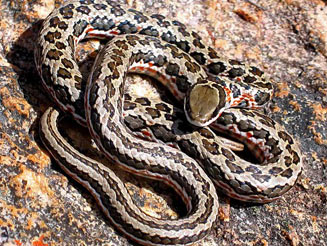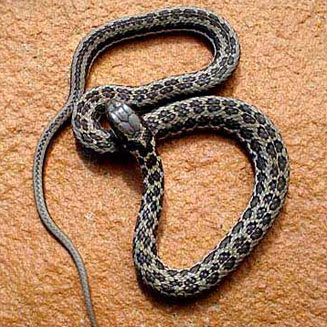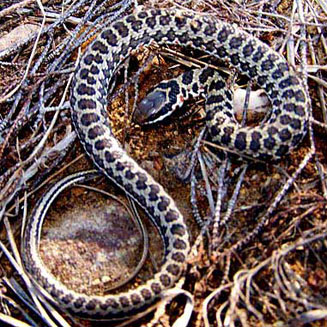|
Psammophylax rhombeatus (Spotted skaapsteker, Rhombic
skaapsteker, Spotted grass snake)
Gevlekte skaapsteker [Afrikaans]
Life >
Eukaryotes
>
Opisthokonta >
Metazoa
(animals) > Bilateria > Deuterostomia >
Chordata >
Craniata > Vertebrata (vertebrates) > Gnathostomata (jawed vertebrates) >
Teleostomi (teleost fish) > Osteichthyes (bony fish) > Class:
Sarcopterygii (lobe-finned fish) > Stegocephalia (terrestrial vertebrates) >
Tetrapoda
(four-legged vertebrates) > Reptiliomorpha > Amniota >
Reptilia (reptiles) >
Romeriida > Diapsida > Lepidosauromorpha > Lepidosauria >
Squamata > Serpentes
(snakes) > Family: Colubridae > Subfamily:
Psammophinae > Genus:
Psammophylax
 |
 |
|
Psammophylax rhombeatus (Spotted skaapsteker, Rhombic
skaapsteker, Spotted grass snake), Western Cape [J.C Els
©, from
SARCA
Virtual Museum] |
Psammophylax rhombeatus (Spotted
skaapsteker, Rhombic skaapsteker, Spotted grass snake), Western Cape [A.
Rebelo
©, from
SARCA
Virtual Museum] |
 |
 |
|
Psammophylax rhombeatus (Spotted
skaapsteker, Rhombic skaapsteker, Spotted grass snake), Western Cape [C.
Dorse and S. van Rooyen
©, from
SARCA
Virtual Museum] |
Psammophylax rhombeatus (Spotted
skaapsteker, Rhombic skaapsteker, Spotted grass snake), Western Cape
[E.R. Le Roux
©, from
SARCA
Virtual Museum] |
Identification
The Spotted skaapsteker is identified by its large eyes
(with round pupils), its nervous movements and its strictly diurnal lifestyle.
It grows to an average length of 85 cm but may reach up to 1.4 meters in length.
Distribution and habitat
Found in the following areas; the
Western Cape, the Eastern Cape, KwaZulu-Natal, Free State, Gauteng, Mpumalanga and Limpopo
( there is also a small Northern Cape population as well 3 populations in
Namibia). Its favoured habitats are fynbos, grassland and moist savanna.
Food
Feeds on
rodents
(e.g.
rats and mice), lizards,
birds,
frogs
and other snakes.
Predators, parasites and disease
Fed on by
birds of
prey (particularly
secretary birds and
snake eagles) and other snakes.
Reproduction
Oviparous (egg laying), lays between 8 and 30 eggs in
summer (the skaapsteker is also know to coil around its eggs).
Longevity
Uncertain it is likely that this snakes average lifespan is
10 years or more.
Medical importance
The venom of this snake poses no threat to man.
Links
References
-
Broadley, D.G. 1983. FitzSimons' Snakes of Southern
Africa. Delta Books, Johannesburg.
-
Marais, J. 2004. A Complete Guide to Snakes of
Southern Africa. Struik Publishing, Cape Town.
|
